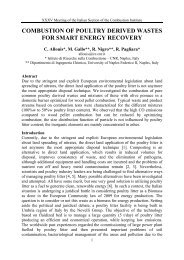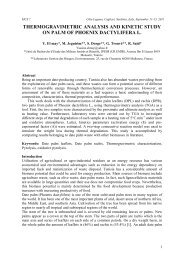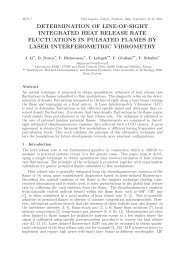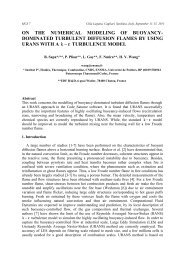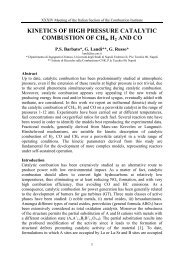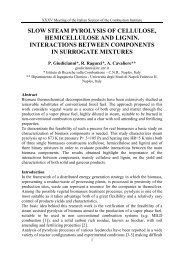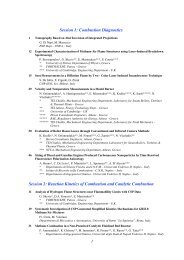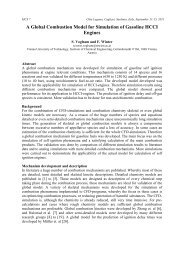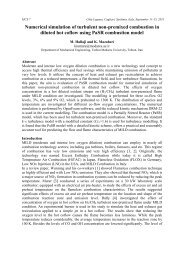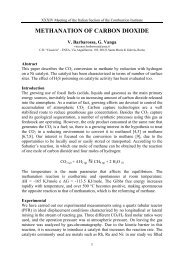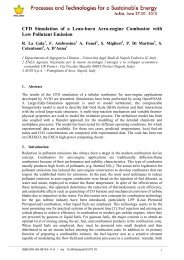Fluidized Bed Gasification of a Natural Biomass - Italian Section of ...
Fluidized Bed Gasification of a Natural Biomass - Italian Section of ...
Fluidized Bed Gasification of a Natural Biomass - Italian Section of ...
Create successful ePaper yourself
Turn your PDF publications into a flip-book with our unique Google optimized e-Paper software.
Processes and Technologies for a Sustainable Energy<br />
fluidized bed on the basis <strong>of</strong> results <strong>of</strong> previous investigations carried out on the same pilot-scale<br />
BFBG [5] and those reported on the scientific literature [6]. In the reported experiments, air was<br />
used as reducing agent and always injected at the bed bottom while the fuel was always fed by<br />
means <strong>of</strong> an over-bed feeding system. The fuel and blast flow rates were mutually adjusted so<br />
that, at the fixed fluidizing velocity, the desired equivalence ratio ER was obtained (where ER is<br />
defined as the ratio between the oxygen content <strong>of</strong> air supply and that required for the<br />
stoichiometric complete combustion <strong>of</strong> the fuel effectively fed to the reactor). The gas generated<br />
in the reactor was sent to the syngas cleaning section composed <strong>of</strong> a high efficiency cyclone and<br />
a wet scrubber (for the removal <strong>of</strong> tars, residual fly ashes and acid gases) and finally incinerated<br />
by a safety flare. An accurate description <strong>of</strong> the plant and <strong>of</strong> experimental procedures is provided<br />
elsewhere [7].<br />
4. THE CONFIGURATIONS OF THE BIOMASS-TO-ENERGY SYSTEM<br />
The configurations <strong>of</strong> the gasification based, biomass-to-energy system investigated in this study<br />
were defined on the basis <strong>of</strong> the following design specifications. The plant is designed to be fed<br />
Table 1. Characteristics <strong>of</strong> the<br />
biomass fuel<br />
Ultimate analysis, %<br />
C 45.3<br />
H 5.6<br />
N 0.5<br />
S 0<br />
Moisture 9.0<br />
Ash 1.2<br />
O (by difference) 38.4<br />
LHVas received, kJ/kg 15700<br />
with a natural biomass: a commercially available beechwood<br />
for domestic heating, having the chemical characteristics<br />
reported in Table 1. The process is designed to produce<br />
electricity, even though additional thermal energy is available<br />
to use in case a demand is present at the installation site. The<br />
electrical size range <strong>of</strong> interest is that <strong>of</strong> small scale plants,<br />
between 100-600kWe. This leads to individuate the<br />
atmospheric bubbling fluidized bed air gasification as the<br />
conversion process to be adopted [4].<br />
The design configurations for the industrial application <strong>of</strong><br />
gasification plants in the range <strong>of</strong> interest can be sketched as a<br />
combination <strong>of</strong> three sections: syngas production, syngas<br />
cleaning and syngas utilization. The first defines the syngas that can be produced and then, for<br />
fixed biomass fuel and gasification technology, the quantity and quality <strong>of</strong> this syngas. The<br />
syngas utilization section indicates the syngas that can be utilized in a specific energy conversion<br />
device and then, for a given machinery (steam turbine, gas engine, internally or externally fired<br />
gas turbine), its temperature, heating value and cleaning level (i.e. tar and dust content but also<br />
that <strong>of</strong> alkaly and inorganic contaminants). The cleaning section must combine the<br />
characteristics <strong>of</strong> the produced syngas and those required by the specific generator set<br />
The gasification section has been designed on the basis <strong>of</strong> an experimental activity carried out<br />
on the pilot scale BFBG operated under autothermal conditions, i.e. with the only external heat<br />
addition being provided for the pre-heating <strong>of</strong> the reducing and fluidizing air stream. The reactor<br />
was operated with the natural biomass, in a bed <strong>of</strong> olivine particles fluidized at a velocity <strong>of</strong><br />
0.6m/s, a bed temperature <strong>of</strong> about 850°C, an air preheating temperature <strong>of</strong> 545°C and with an<br />
equivalence ratio ER <strong>of</strong> 0.28. The performances <strong>of</strong> the BFBG were measured and recorded only<br />
when the chemical composition <strong>of</strong> the produced syngas and the temperature pr<strong>of</strong>ile along the<br />
reactor reached stedy-state conditions (Table 2). The obtained results have been combined with a<br />
recently defined environmental assessment tool, the Material Flow Analysis, which is named<br />
Substance Flow Analysis when it is referred to a specific chemical species. MFA/SFA is a<br />
systematic assessment <strong>of</strong> the flows and stocks <strong>of</strong> materials and elements within a system defined<br />
in space and time. It connects the sources, the pathways, and the intermediate and final sinks <strong>of</strong><br />
each species in a specific process [8]. The quantified flow diagrams reported in Figure 1 are the<br />
2



